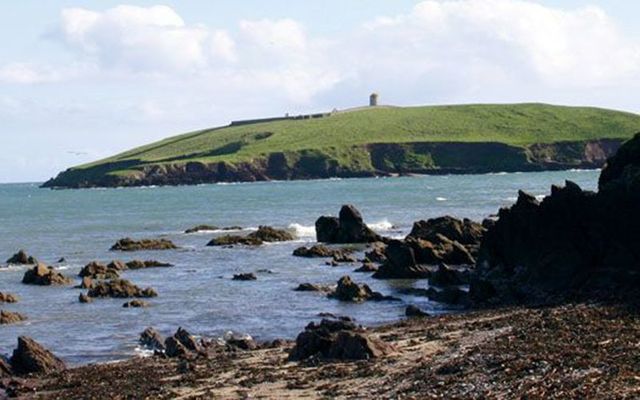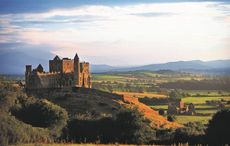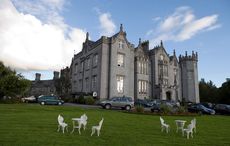The piece of Cork that lies between Ballymaloe and Youghal contains some of the most exciting spots, both ancient and modern, that can be found within a short trip through the Irish countryside.
A gentle country, with a rolling landscape of green fields and hedges, it has a long border of coastline with romantic islands at each end. A day trip will give you a feel of it, but half-days spent here and there would make it easy to pass a very pleasurable week in the region.
Our trip from the fabulous Ballymaloe House begins in the very remarkable seaside village of Shanagarry. Its great claim to historical fame is that surrounding lands were granted by King Charles II to Admiral Penn and managed by his son William in years before he established his Quaker settlement in Pennsylvania. Traces of Penn’s castle remain – but modern Shanagarry has a great deal more to it than that.
Follow signposts to Ballymaloe Cookery School, where you would be wise to yield to the temptation of booking in for a half-day course or something very much longer. If you have less time than that, don’t pass without making a tour of the shop, gardens and the farm. Most of the garden has been created, or rescued after a period of neglect, within the past twenty years. Part of it is for pleasure, part for the fruit and veg, but even the culinary side has been developed as a thing of beauty. Farm stock includes rare breeds such as a herd of beautiful black Kerry cows.
Back on the main street of the village, a white-painted building that stands beside the castle is home to the Shanagarry Design Center, another emporium offering the very best of Irish craftwork, together with some fine imported goods and a very friendly café. It is owned by Kilkenny Design, the organization that was set up fifty years ago in the stable yard of Kilkenny Castle and brought about a revolution in the variety and quality of Irish crafts.
Farther down the street, almost hidden among trees, there are two potteries, both creating first-class ware with highly original designs. We visited works and showrooms that bear the extremely unlikely title of Jack O’Patsy. Its genial proprietor, Pat Collins, derived the name from an Irish-sounding Italian one, Giacapazzi. You can watch the magical skill of potters and enjoy a cup of tea there, too. Across the path is the workplace of Stephen Pearce, designer, and producer of long-established Shanagarry ware.
Proceed down the street, past the Post Office, and across the crossroads for a first encounter with the seaside.
It’s a romantic spot: miles of strand cut off from the modern world by sand dunes, with distant horizons and a picture-postcard island with a lighthouse. The island is one of two lying off Ballycotton, which you find by following the coast road to the west.

Are you planning a vacation in Ireland? Looking for advice or want to share some great memories? Join our Irish travel Facebook group.
A fishing village where houses large and small climb over rocks above the busy harbor, Ballycotton is famous both for sport fishing and for bird-watching. Well-appointed boats take determined fisherfolk far and wide, while others try their luck from the pier or nearby cliffs. Since 1858, generations of Ballycotton lifeboat crews have carried out a succession of incredibly dangerous rescue operations under conditions that are hard to imagine on a calm summer’s day.
From Ballycotton follow well-signposted, switchback Coast Road for 15 miles (24 km) where you may turn right at T-junction to visit Knockadoon, another headland with another island. Then you go north for Youghal, a harbor town positively seething with history, which it combines with an abundance of choices of good food and miles of the Golden Strand. Find a parking place for your car, perhaps beside one of two little harbors, and savory delights of town on foot.
Youghal began its life as a seaport in the days of Vikings, who took advantage of the shelter provided by hills on either side of the bay. At the head of the bay, broad River Blackwater meets the sea, and that provided settlers with something of a highway inland. But today’s town really began when the building of walls that still surround it was commissioned in 1275.
Once upon a time, Youghal was the premier port of Ireland, dealing with a greater volume of trade than Dublin. But those days passed away when ships grew too big for the shallow waters of the bay. Today its waterfront is the preserve of a variety of pleasure craft. Visit the excellent Information Center beside the southern of two little harbors and get a map of the town. Across the road from the Center gable end of the pub has a truly splendid mural with a romantic picture of a whaling ship and crew. The pub was re-named Moby Dick in commemoration of the transformation of Youghal to the New England port of New Bedford by John Huston when he filmed Melville’s story there in 1954.
We wandered through town, under Clock Gate, built in the 18th century as a gaol-house, no doubt keeping the population very well aware of the risks of criminal behavior.
A little farther along, Red House provided a good lunch in one of the spacious courtyards that hide behind narrow streets. Close by is Tynte’s Castle, home of Elizabeth, widow of Edmund Spenser, and muse for his most beautiful poem, Epithalamion. From this old stone castle, we walked uphill to St. Mary’s Collegiate Church. Walking anywhere in Youghal brings you past countless houses and castles and bits of wall that have been in use since medieval times. Few towns in Ireland can equal its atmosphere of times long gone.
Added to from time to time and still very much in use, St. Mary’s church makes a fair claim to be one of oldest places of unbroken worship in Ireland. Like the town itself, it has a special air of antiquity. Within its stone walls and beneath old roof beams great events of the lives of citizens have been celebrated and prayed for over seven hundred years – as they still are.
If you are in search of something more solid than the indefinable air of sanctity, don’t miss the memorial to entrepreneur Richard Boyle, ennobled as First Earl of Cork. In his Elizabethan clothes, he lies between the effigies of his two wives and above little statues of his ten children.
Close to the church is Myrtle Grove, reputed to have been Sir Walter Raleigh’s residence for a while. If you go north from Youghal you have the possibility of following the estuary of Blackwater as it wanders through ancient woodland. But that would be another day’s trip. If you go south, you might visit the incredible Youghal strand which extends for no less than three miles (5 km). Sixteen miles through Castlemartyr and Ladysbridge will bring you back to Ballymaloe.
*Originally published in July 2013. Updated in November 2023.




Comments